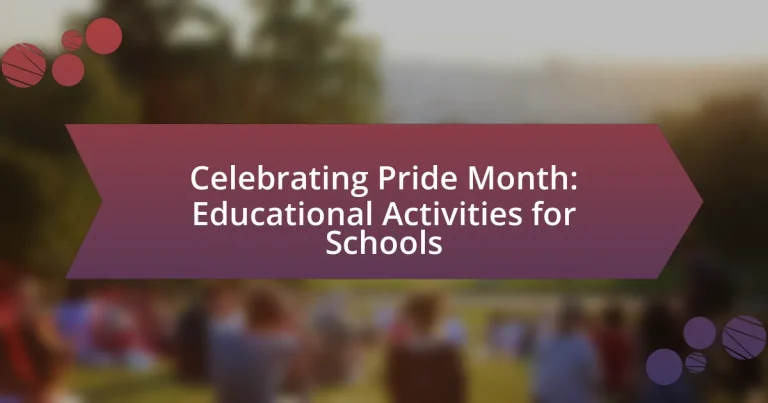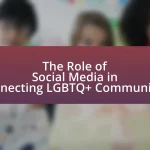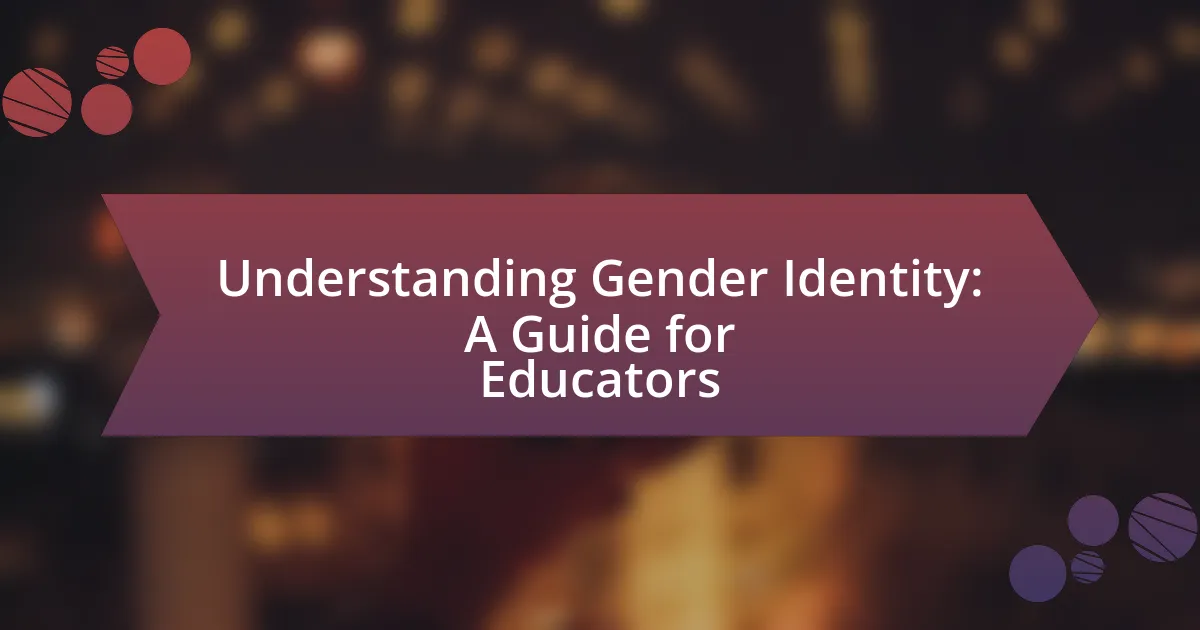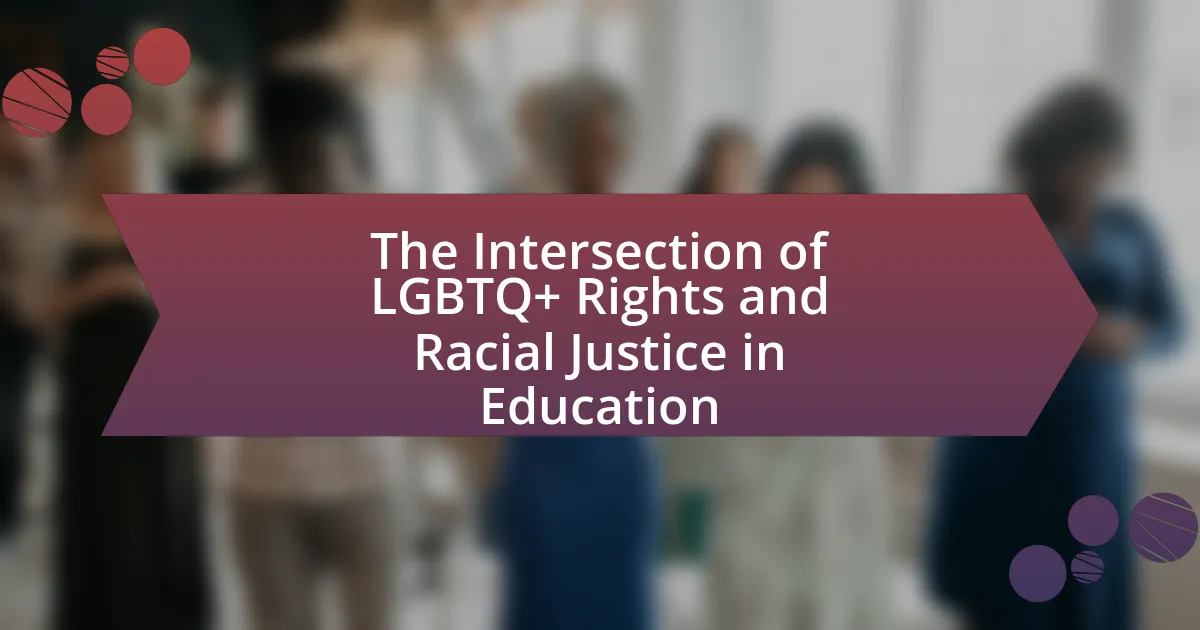Pride Month is an annual celebration in June that honors the LGBTQ+ community and commemorates the Stonewall Riots of 1969, a significant event in the fight for LGBTQ+ rights. Schools recognize Pride Month to promote inclusivity, educate students about diversity, and create supportive environments for all students, regardless of sexual orientation or gender identity. The article outlines the historical origins of Pride Month, its significance, and the core values of inclusivity, acceptance, and equality. It also discusses various educational activities, events, and strategies that schools can implement to foster understanding and support for LGBTQ+ individuals, ultimately contributing to a more equitable society.
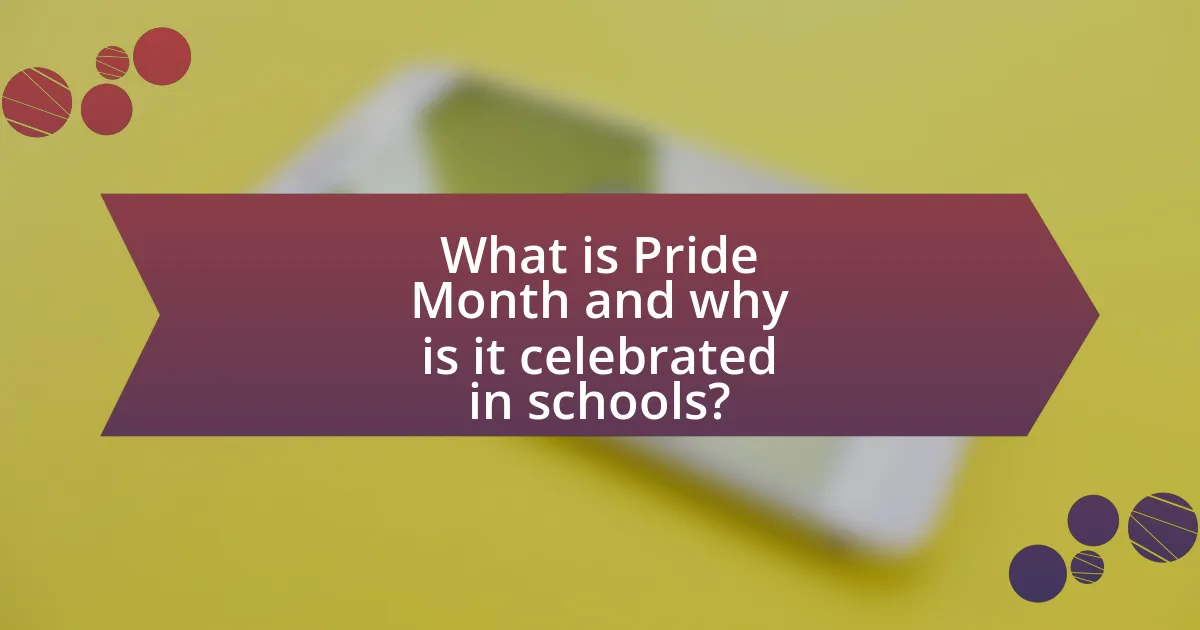
What is Pride Month and why is it celebrated in schools?
Pride Month is an annual celebration in June that honors the LGBTQ+ community and commemorates the Stonewall Riots of 1969, which were pivotal in the fight for LGBTQ+ rights. Schools celebrate Pride Month to promote inclusivity, educate students about diversity, and foster a supportive environment for all students, regardless of their sexual orientation or gender identity. Celebrating Pride Month in educational settings helps raise awareness about LGBTQ+ issues, encourages acceptance, and combats discrimination, thereby contributing to a more equitable society.
How did Pride Month originate and what is its significance?
Pride Month originated in June 1970 to commemorate the first anniversary of the Stonewall Riots, a pivotal event in the LGBTQ+ rights movement that occurred in June 1969 in New York City. The significance of Pride Month lies in its role as a celebration of LGBTQ+ identities, history, and culture, while also serving as a platform for advocacy against discrimination and for equal rights. The month promotes visibility and awareness of LGBTQ+ issues, fostering a sense of community and solidarity among individuals and allies.
What historical events led to the establishment of Pride Month?
The establishment of Pride Month is primarily linked to the Stonewall Riots of June 1969, which were a series of spontaneous demonstrations by members of the LGBTQ+ community in response to a police raid at the Stonewall Inn in New York City. These riots are widely regarded as a catalyst for the modern LGBTQ+ rights movement, leading to the first Pride marches in 1970 to commemorate the anniversary of the riots. The significance of these events is underscored by the fact that they marked a turning point in the fight for LGBTQ+ rights, fostering greater visibility and activism within the community. Consequently, in 1999, President Bill Clinton officially declared June as Pride Month, recognizing the contributions of LGBTQ+ individuals and the ongoing struggle for equality.
Why is it important for schools to recognize Pride Month?
It is important for schools to recognize Pride Month because it fosters an inclusive environment that supports LGBTQ+ students and promotes understanding among all students. Recognizing Pride Month helps to combat discrimination and bullying, as studies show that LGBTQ+ youth face higher rates of harassment in educational settings. For instance, the 2019 National School Climate Survey found that 70% of LGBTQ+ students experienced verbal harassment at school. By acknowledging Pride Month, schools can implement educational activities that raise awareness about LGBTQ+ history and rights, thereby encouraging empathy and respect among students.
What are the core values associated with Pride Month?
The core values associated with Pride Month are inclusivity, acceptance, and equality. Inclusivity emphasizes the importance of recognizing and celebrating diverse sexual orientations and gender identities, fostering a sense of belonging for all individuals. Acceptance promotes understanding and support for LGBTQ+ communities, encouraging society to embrace differences rather than stigmatize them. Equality advocates for the equal rights and treatment of LGBTQ+ individuals, highlighting the ongoing struggle against discrimination and the need for legal protections. These values are rooted in the historical context of Pride Month, which originated from the Stonewall Riots in 1969, a pivotal event in the fight for LGBTQ+ rights.
How do inclusivity and diversity play a role in Pride Month celebrations?
Inclusivity and diversity are central to Pride Month celebrations as they promote acceptance and representation of all identities within the LGBTQ+ community. These celebrations highlight the importance of recognizing various sexual orientations, gender identities, and cultural backgrounds, fostering a sense of belonging and empowerment. For instance, events such as parades and educational workshops often feature diverse voices and experiences, ensuring that marginalized groups, including people of color and transgender individuals, are visible and heard. This representation is crucial, as studies show that inclusive environments lead to increased well-being and mental health among LGBTQ+ individuals, reinforcing the significance of diversity in creating supportive communities during Pride Month.
What messages of acceptance and support are conveyed during Pride Month?
Pride Month conveys messages of acceptance and support for the LGBTQ+ community, emphasizing the importance of equality, diversity, and inclusion. These messages are reinforced through various events, such as parades and educational initiatives, which promote understanding and respect for all sexual orientations and gender identities. For instance, organizations often highlight the significance of allyship, encouraging individuals to stand in solidarity with LGBTQ+ individuals, thereby fostering a culture of acceptance. Additionally, statistics show that inclusive environments lead to improved mental health outcomes for LGBTQ+ youth, underscoring the necessity of these supportive messages during Pride Month.
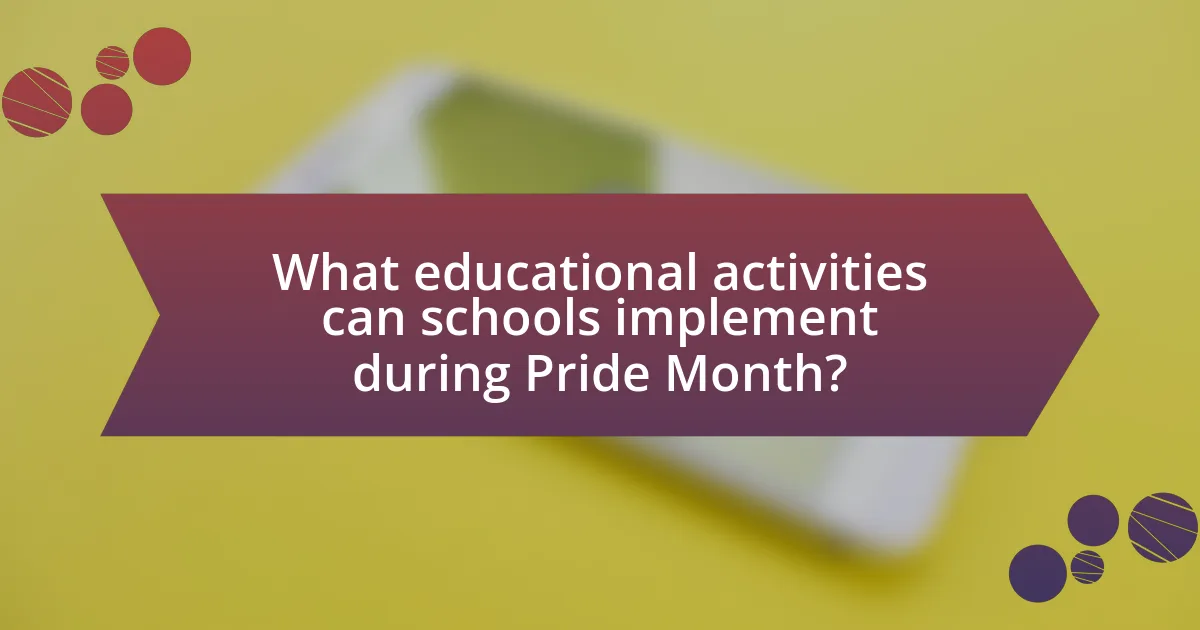
What educational activities can schools implement during Pride Month?
Schools can implement various educational activities during Pride Month, such as hosting workshops on LGBTQ+ history, organizing guest speaker events featuring LGBTQ+ activists, and facilitating discussions on inclusivity and diversity. These activities promote awareness and understanding of LGBTQ+ issues, fostering a supportive environment. For instance, incorporating lessons on the Stonewall Riots, which were pivotal in the LGBTQ+ rights movement, can provide historical context and significance. Additionally, schools can create art projects that celebrate LGBTQ+ identities, allowing students to express their support creatively. Engaging students in these activities not only educates them about LGBTQ+ rights but also encourages empathy and respect for all individuals.
How can schools incorporate Pride Month themes into their curriculum?
Schools can incorporate Pride Month themes into their curriculum by integrating LGBTQ+ history, literature, and social issues across various subjects. For instance, educators can include texts by LGBTQ+ authors in English classes, such as works by James Baldwin or Audre Lorde, to foster discussions about identity and representation. Additionally, social studies lessons can cover significant events in LGBTQ+ history, such as the Stonewall Riots, to provide context and understanding of the ongoing struggle for rights. Research indicates that inclusive curricula can improve the school climate for LGBTQ+ students, as highlighted in the 2019 GLSEN National School Climate Survey, which found that schools with inclusive curricula reported lower levels of harassment and discrimination.
What subjects can benefit from integrating Pride Month discussions?
Subjects that can benefit from integrating Pride Month discussions include social studies, literature, health education, and art. Social studies can explore the historical context of LGBTQ+ rights and movements, enhancing students’ understanding of societal changes. Literature classes can analyze works by LGBTQ+ authors, fostering empathy and diverse perspectives. Health education can address topics related to sexual orientation and gender identity, promoting inclusivity and awareness of mental health issues faced by LGBTQ+ individuals. Art classes can encourage creative expression through projects that celebrate diversity and representation. Integrating these discussions enriches the curriculum and supports a more inclusive educational environment.
How can literature and art be used to celebrate Pride Month?
Literature and art can be used to celebrate Pride Month by showcasing LGBTQ+ voices and experiences through various mediums. For instance, literature can include novels, poetry, and essays that highlight the struggles and triumphs of LGBTQ+ individuals, such as “Giovanni’s Room” by James Baldwin or “The Color Purple” by Alice Walker, which explore themes of identity and acceptance. Art can manifest in visual forms, such as paintings, sculptures, and performances that reflect LGBTQ+ culture and history, like Keith Haring’s iconic works that advocate for AIDS awareness and LGBTQ+ rights. These creative expressions not only educate audiences about the LGBTQ+ community but also foster empathy and understanding, making them essential tools for celebration during Pride Month.
What types of events can schools organize for Pride Month?
Schools can organize various events for Pride Month, including educational workshops, pride parades, guest speaker sessions, art exhibitions, and film screenings. Educational workshops can focus on LGBTQ+ history and rights, promoting awareness and understanding among students. Pride parades allow students to celebrate diversity and inclusivity in a vibrant, community-oriented atmosphere. Guest speaker sessions can feature LGBTQ+ activists or allies sharing their experiences, fostering dialogue and empathy. Art exhibitions can showcase student artwork that reflects themes of pride and acceptance, while film screenings can present documentaries or films that highlight LGBTQ+ stories and issues. These events collectively contribute to a supportive environment that celebrates diversity and promotes inclusivity within the school community.
How can schools host assemblies or guest speaker events focused on LGBTQ+ topics?
Schools can host assemblies or guest speaker events focused on LGBTQ+ topics by collaborating with local LGBTQ+ organizations and inviting knowledgeable speakers to share their experiences and insights. This approach not only provides authentic perspectives but also fosters a supportive environment for discussions on diversity and inclusion. Research indicates that educational programs addressing LGBTQ+ issues can significantly reduce bullying and improve school climate, as highlighted in the 2019 GLSEN National School Climate Survey, which found that schools with inclusive curricula reported lower levels of harassment. By implementing these events, schools can actively promote understanding and acceptance among students.
What role do parades and community events play in school celebrations?
Parades and community events serve as vital components of school celebrations by fostering inclusivity and promoting awareness of diverse cultures and identities. These events create a platform for students to express their individuality and solidarity, particularly during occasions like Pride Month, where visibility and representation are crucial. Research indicates that participation in such events enhances students’ sense of belonging and community engagement, which is essential for their social and emotional development. For instance, a study published in the Journal of Educational Psychology found that students who engage in community celebrations report higher levels of school connectedness and lower levels of bullying. Thus, parades and community events not only celebrate diversity but also contribute to a supportive educational environment.
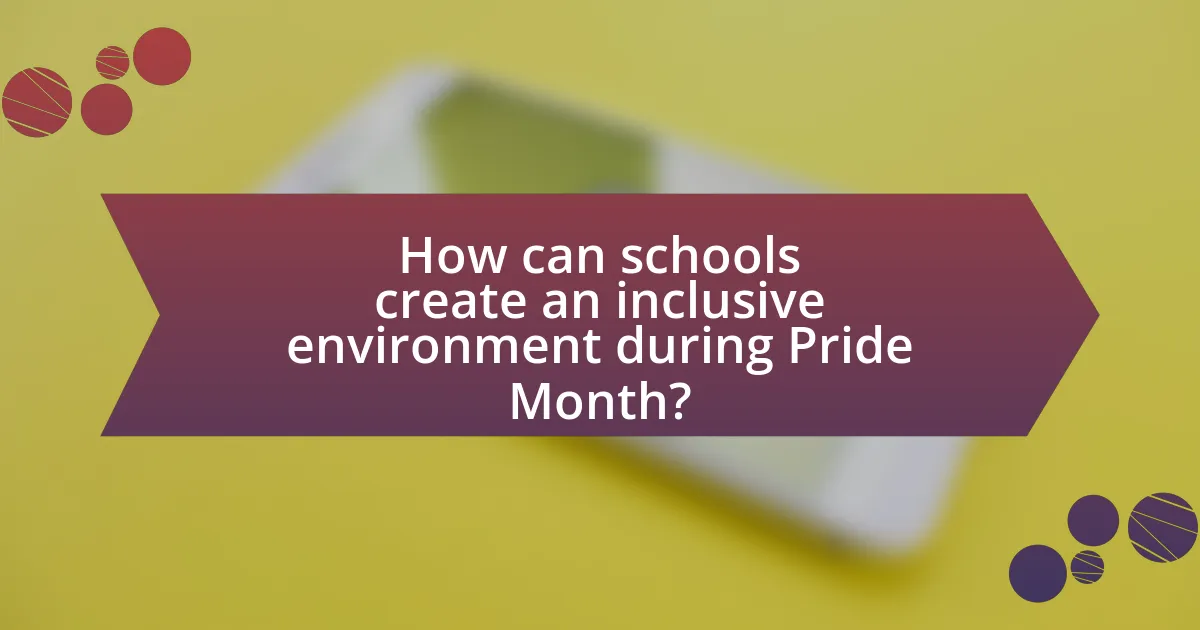
How can schools create an inclusive environment during Pride Month?
Schools can create an inclusive environment during Pride Month by implementing educational programs that promote awareness and understanding of LGBTQ+ issues. These programs can include workshops, discussions, and activities that celebrate diversity and encourage respect for all identities. For instance, integrating LGBTQ+ history into the curriculum can provide students with a broader perspective on societal contributions and challenges faced by the community. Research shows that inclusive educational practices lead to improved mental health outcomes for LGBTQ+ students, as highlighted in the 2019 GLSEN National School Climate Survey, which found that supportive school environments significantly reduce feelings of isolation and bullying among these students.
What strategies can educators use to foster acceptance and understanding?
Educators can foster acceptance and understanding by implementing inclusive curricula that reflect diverse perspectives and experiences. This approach encourages students to engage with various cultures, identities, and histories, promoting empathy and respect. For instance, integrating literature from LGBTQ+ authors and discussing historical events related to the LGBTQ+ rights movement can provide students with a broader understanding of these communities. Research indicates that inclusive education can reduce prejudice and increase acceptance among students, as shown in a study published in the Journal of Educational Psychology, which found that students exposed to diverse narratives demonstrated greater empathy and reduced bias.
How can teachers address potential challenges or resistance to Pride Month activities?
Teachers can address potential challenges or resistance to Pride Month activities by fostering an inclusive environment through open dialogue and education. By initiating conversations about diversity and the importance of Pride Month, educators can help students understand the significance of LGBTQ+ rights and history. Research indicates that inclusive curricula can reduce bullying and increase acceptance among peers, as seen in studies conducted by GLSEN, which found that LGBTQ+ inclusive education leads to safer school environments. Additionally, teachers can provide resources and support for students and families who may feel uncomfortable, ensuring that all voices are heard and respected.
What resources are available to support LGBTQ+ students and their allies?
LGBTQ+ students and their allies can access various resources, including support groups, educational materials, and counseling services. Organizations such as GLSEN (Gay, Lesbian & Straight Education Network) provide resources specifically designed for schools, including lesson plans and training for educators to create inclusive environments. Additionally, The Trevor Project offers crisis intervention and suicide prevention services for LGBTQ+ youth, emphasizing the importance of mental health support. Research indicates that schools with supportive resources see improved academic performance and mental well-being among LGBTQ+ students, highlighting the effectiveness of these initiatives.
What are some best practices for celebrating Pride Month in schools?
Best practices for celebrating Pride Month in schools include incorporating LGBTQ+ history and contributions into the curriculum, hosting inclusive events such as assemblies or workshops, and creating safe spaces for discussions about identity and acceptance. Research indicates that inclusive education fosters a sense of belonging and reduces bullying; for instance, a study by GLSEN found that LGBTQ+ inclusive curricula significantly improve school climate. Additionally, displaying Pride flags and materials can visibly support LGBTQ+ students, reinforcing their presence and importance within the school community.
How can schools evaluate the effectiveness of their Pride Month activities?
Schools can evaluate the effectiveness of their Pride Month activities by collecting feedback from students, staff, and parents through surveys and focus groups. This method allows schools to gauge the impact of their initiatives on awareness, inclusivity, and community engagement. For instance, a study by GLSEN found that schools with inclusive curricula reported higher levels of student safety and belonging, indicating that effective Pride Month activities can lead to positive outcomes in school climate. Additionally, analyzing participation rates in events and tracking changes in student attitudes towards LGBTQ+ issues can provide measurable insights into the success of these activities.
What tips can educators follow to ensure meaningful engagement during Pride Month?
Educators can ensure meaningful engagement during Pride Month by incorporating inclusive curricula that reflect LGBTQ+ histories and contributions. This approach fosters understanding and respect among students, as studies show that inclusive education can reduce bullying and improve mental health outcomes for LGBTQ+ youth. Additionally, hosting events such as guest speaker sessions with LGBTQ+ activists or organizing workshops on diversity can create a supportive environment. Research indicates that schools that actively promote inclusivity see higher levels of student engagement and community support, reinforcing the importance of these practices during Pride Month.
